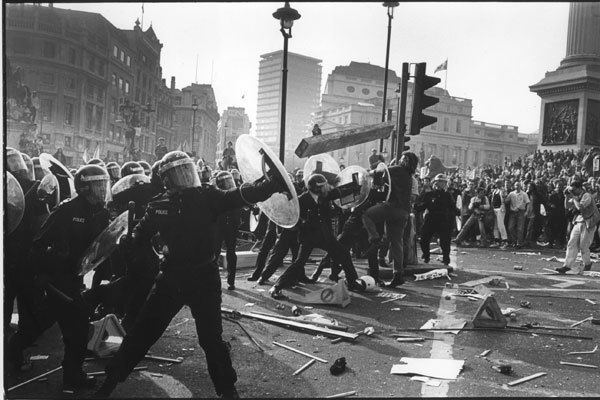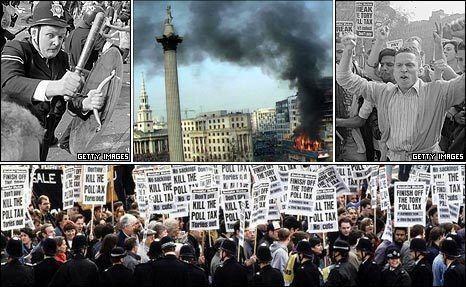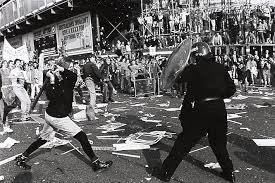Date 31 March 1990 | ||
 | ||
Location Kennington Park, London, United Kingdom | ||
Thatcher poll tax riots 1990
The poll tax riots were a series of riots in British towns and cities during protests against the poll tax (officially known as the "Community Charge"), introduced by the Conservative government of Prime Minister Margaret Thatcher. The largest protest occurred in central London on Saturday, 31 March 1990, shortly before the tax was due to come into force in England and Wales.
Contents
- Thatcher poll tax riots 1990
- Background
- 1989
- Events of the day
- Responses
- Fall of Thatcher
- Abandonment of the poll tax
- Films
- References

Background

The advent of the poll tax was due to an effort to alter the way the tax system was used to fund local government in Britain. The system in place until this time was called "rates" and had been in place in some form from the beginning of the 17th century. The rates system has been described as "a levy on property, which in modern times saw each taxpayer paying a rate based on the estimated rental value of their home."
1989

The Thatcher government had long promised to replace domestic rates, which were unpopular, especially among Conservative voters. They were seen by many as an unfair way of raising revenue for local councils. It was levied on houses rather than people.

The proposed replacement was a flat-rate per capita Community Charge - "a head tax that saw every adult pay a fixed rate amount set by their local authority." The new Charge was widely called a "poll tax" and was introduced in Scotland in 1989 and in England and Wales a year later. The Charge proved extremely unpopular: while students and the unemployed only had to pay a small percentage, large families using a relatively small house saw their charges go up considerably, and the tax was thus accused of saving the rich money and moving the expenses onto the poor.

In November 1989 the All Britain Anti-Poll Tax Federation was set up by the Militant tendency. Other groups such as the 3D (Don't Register,Don't Pay, Don't Collect) network provided national coordination for anti poll tax unions who were not aligned to particular political factions. The All Britain Federation called a demonstration in London for 31 March 1990 which all of the major networks organised for. Three days before the event, organisers realised the march would be larger than 60,000 (the capacity of Trafalgar Square) and asked permission from the MPS and the Department of the Environment to divert the march to Hyde Park. The request was denied on the basis that the policing had been arranged for Trafalgar Square and there was no time to re-plan it. A building site on Trafalgar Square with easily accessible supplies of bricks and scaffolding was left largely unsecured while the police set up their centre of operations on the other side of the square.
Events of the day
On 31 March 1990, people began gathering in Kennington Park from noon. Turnout was encouraged by fine weather, and between 180,000 and 250,000 arrived. The police report, a year after the riot, estimated the crowd at 200,000. An abandoned rally by the Labour Party may also have contributed to the number of protesters. The march began at Kennington Park at 1:30pm, moving faster than planned because some of the crowd had forced open the gates of the park, presumably in order to avoid being forced through smaller gates. This split the march over both sides of the road, and protesters continued in much the same way for the rest of the route.
By 2:30pm, Trafalgar Square was nearing its capacity. Unable to continue moving easily into Trafalgar Square, at about 3pm the march stopped in Whitehall. The police, worried about a surge towards the new security gates of Downing Street, blocked the top and bottom of Whitehall, and lined the pavement refusing to let people leave the road. Additional Police units were dispatched to reinforce the officers manning the barrier blocking the Downing street side of Whitehall. The section of the march which stopped opposite Downing Street reportedly contained veteran anarchists and a group called "Bikers Against The Poll Tax", some of whom became aggravated by reportedly heavy-handed arrests, including one of a man in a wheelchair.
Mounted riot police were brought in, behind this immobilised section of the march, in theory to clear the protesters from Whitehall, despite both retreat and advance being blocked by further lines of police. Meanwhile, the tail-end had been diverted at the Parliament Square end of Whitehall, and the anarchists it had attracted were at the head of an unpoliced portion of the march. These people walked to Richmond Terrace, bringing the diverted march into Whitehall, opposite Downing Street and behind the police lines on that side of Whitehall. The protesters at the rear of the stationary group, being faced by Mounted police seemingly preparing to charge, sat down on for safety. Despite black-clothed and scarf-masked people running through seemingly from behind the police lines and urging them up, they remained seated until physically dragged away and arrested for "Obstructing Whitehall". The Mounted Police then advanced at speed, forcing the Whitehall section of the march to fight its way into Trafalgar Square.
From 4pm, with the rally nearly officially over, contradictory reports began to arise. According to some sources, mounted riot police (officially used in an attempt to clear Whitehall of protesters) charged out of a side street into the crowd in Trafalgar Square. Whether intentional or not, this was interpreted by the mob as a provocation, fueling anger in the Square where the police had already been pushing sections of crowd back into corners leaving no way out except through the police. At 4:30pm, four shielded police riot vans drove into the crowd (a tactic in dealing with mass demonstrations at the time) outside the South African Embassy, attempting to force through to the entrance to Whitehall where police were re-grouping. The crowd attacked the vans with wooden staves and scaffolding poles. Soon after, rioting began to escalate.
By 4:30pm police had closed the main Underground stations in the area and southern exits of Trafalgar Square, making it difficult for people to disperse. Coaches had been parked south of the river, so many marchers tried to move south. At this point, Militant Fed stewards were withdrawn on police orders. Sections of the crowd, including unemployed coal miners, climbed scaffolding and rained debris on the police below. At 5pm, builders' cabins below the scaffolding caught fire, followed by a room in the South African Embassy on the other side of the Square. The smoke from the fires caused near darkness in the Square and produced a 20-minute lull in rioting.
Between 6 and 7pm, the police opened the southern exits of the Square and slowly moved people out of Trafalgar Square. A large section of the crowd was moved back down Northumberland Avenue and allowed over the River Thames in order to return to their organised transport. Two other sections of demonstrators, now very angry and aggravated, were pushed north into the wealthy shopping streets of West End, which suffered reported theft and vandalism. Published accounts detail shop windows being broken, goods looted, and cars being overturned in Piccadilly Circus, Oxford Street, Regent Street, Charing Cross Road, and Covent Garden. Police ordered pubs to close.
The demonstrators mixed in with the general public. By midnight, released figures claimed 113 were injured, mostly members of the public, but also police officers; and 339 people had been arrested. Scuffles between rioters and police continued until 3am. Rioters attacked numerous shops, most notably Stringfellow's nightclub, and car showrooms; and Covent Garden cafés and wine bars were set ablaze, along with motor vehicles.
Responses
The response of the London police, the government, the Labour Party and the labour movement and some of the Marxist and Trotskyist left, notably the Militant tendency, was to condemn the riot as senseless and to blame anarchists. On ITV News at Ten that evening, the footage had already been rearranged to show the later attacks on the police lines as before the earlier police containment and horse charges. Tommy Sheridan of The Scottish Socialist Party condemned the protesters. The next day, Steve Nally, also a Socialist Party member and Secretary of the All Britain Anti-Poll Tax Federation, said that they would "hold an enquiry and name names.". Many others denounced the All Britain Anti-Poll Tax Federation position and defended those who fought back against the police attacks. Danny Burns for example said: "Often attack is the only effective form of defence and, as a movement, we should not be ashamed or defensive about these actions, we should be proud of those who did fight back."
The UK Socialist Workers' Party (SWP), which was blamed for the violence by some in the media and by Labour MP George Galloway, refused to condemn protesters, calling the events a "police riot." Pat Stack, then a member of the SWP's Central Committee, told The Times: "We did not go on the demonstration with any intention of fighting with the police, but we understand why people are angry and we will not condemn that anger."
In contradiction to what was said at the time by the London police, the government, the Labour Party and the labour movement and most of the Marxist and Socialist left, the 1991 police report concluded there was "no evidence that the trouble was orchestrated by left-wing anarchist groups." Afterwards, the non-aligned Trafalgar Square Defendants Campaign was set up, committed to unconditional support for the defendants, and to accountability to the defendants. The Campaign acquired more than 50 hours of police video. Use of these was influential in acquitting many of the 491 defendants, suggesting the police had fabricated or inflated charges.
In March 1991, the police report suggested additional contributing internal police factors: squeezed overtime budgets which led to the initial deployment of 2,000 men, insufficient given the number of demonstrators; a lack of riot shields (400 "short" riot shields were available); and erratic or poor-quality radio, with a lag of up to five minutes in the computerised switching of radio messages during the evening West End rioting. Prime Minister Thatcher was at a conference of the Conservative Party Council in Cheltenham. The poll tax was the focus of the conference; as coverage of the demonstrations unfolded, speculation developed for the first time about Thatcher's position as leader.
Fall of Thatcher
The riot in central London did much to contribute to the downfall of Margaret Thatcher, who resigned as Prime Minister on 28 November the same year. The national opposition to the poll tax (especially vehement in the North of England and Scotland) was the major factor; an opinion poll had found 78% opposed to it. John Major, who succeeded Thatcher, announced that the tax would be abolished.
Abandonment of the poll tax
John Major announced in his first parliamentary speech as Prime Minister that the poll tax was to be replaced by Council Tax. The council tax came into effect in 1992. Similar to the previous system of rates, the new system set tax levels on property value. Although it was not directly linked to income, the council tax took ability to pay into consideration unlike the poll tax.
